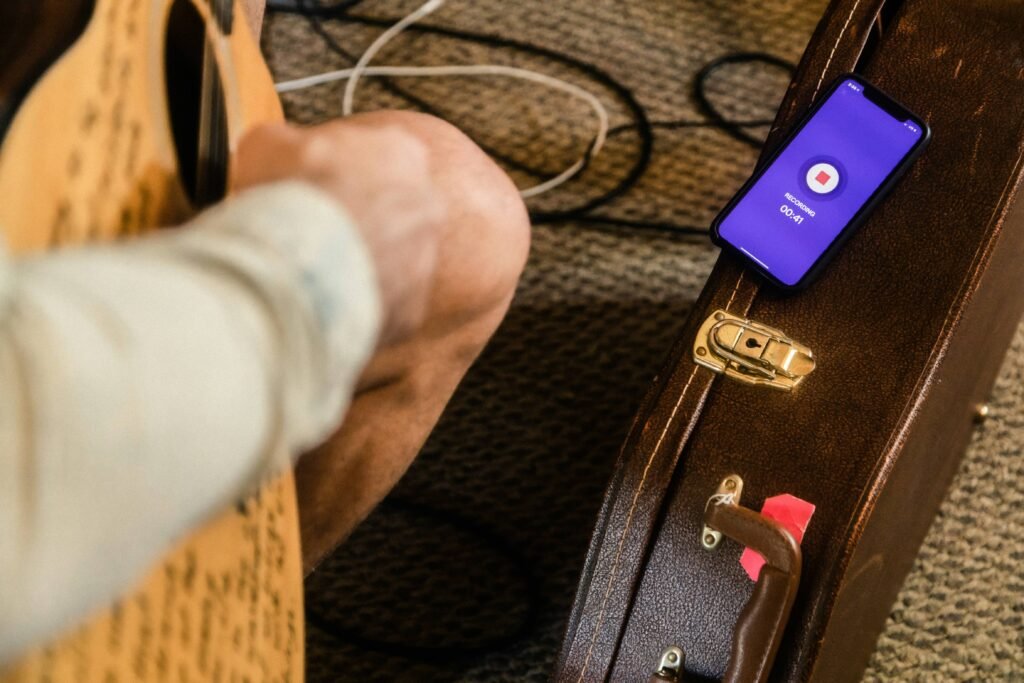Table of Contents

Playing guitar with a metronome is an essential skill for musicians of all levels. Whether you’re a beginner learning basic chords or an advanced player honing your technique, the metronome is a valuable tool for improving your rhythm, timing, and overall musicality. In this guide, we’ll explore everything you need to know to effectively practice guitar with a metronome.
Introduction to Playing Guitar with a Metronome
Rhythm is the backbone of music, and developing a strong sense of timing is crucial for guitarists. A metronome is a device that produces a steady pulse of beats at a specific tempo, allowing musicians to practice playing in time with precision and accuracy. Using a metronome can help improve your timing, rhythm, and ability to play with other musicians.
Choosing the Right Metronome
Before you start practising with a metronome, it’s essential to choose the right one for your needs. There are several types of metronomes available, including mechanical metronomes, digital metronomes, and smartphone apps. Consider factors such as ease of use, features, and portability when selecting a metronome that suits your preferences.
Getting Started with a Metronome
Once you’ve chosen a metronome, it’s time to start practising with it. Here are some steps to get started:
Setting the Tempo
- Begin by selecting a tempo that is comfortable for you. Start with a slow tempo and gradually increase the speed as you become more comfortable.
Using Different Time Signatures
- Experiment with different time signatures, such as 4/4, 3/4, and 6/8, to develop your sense of rhythm and timing in various musical contexts.
Practicing Basic Guitar Techniques with a Metronome
A metronome can be used to practice a wide range of guitar techniques, from basic chords to advanced soloing. Here are some exercises to try:
Strumming Exercises
- Practice strumming basic chords in time with the metronome, focusing on maintaining a steady rhythm and consistent dynamics.
Fingerpicking Exercises
- Play fingerstyle patterns and exercises with the metronome to improve your fingerpicking technique and accuracy.
Scale Practice
- Use the metronome to practice scales and arpeggios at different tempos, focusing on playing each note evenly and in time with the beat.
Advanced Techniques for Metronome Practice
Once you’re comfortable with basic exercises, you can explore more advanced techniques with the metronome:
Syncopation Exercises
- Practice playing off-beat rhythms and syncopated patterns to develop a strong sense of groove and rhythm.
Odd Time Signatures
- Challenge yourself by practising in odd time signatures such as 5/4 or 7/8, which can improve your ability to play in unconventional meters.
Playing with Subdivisions
- Divide the beat into smaller subdivisions (e.g., eighth notes or sixteenth notes) and practice playing intricate rhythms and patterns with the metronome.
Tips for Effective Metronome Practice
To get the most out of your metronome practice sessions, keep the following tips in mind:
- Start Slow: Begin practising at a comfortable tempo and gradually increase the speed as you become more confident.
- Focus on Precision: Pay close attention to your timing and aim to play each note or chord precisely in time with the metronome.
- Incorporate Dynamics: Don’t forget to incorporate dynamics and expression into your playing, even when practising with a metronome.
Common Mistakes to Avoid
While practising with a metronome can be beneficial, it’s essential to avoid these common mistakes:
- Relying Too Heavily on the Metronome: While the metronome is a helpful tool, don’t become overly reliant on it. Practice playing without the metronome to develop your internal sense of rhythm.
- Ignoring Dynamics and Expression: Don’t sacrifice dynamics and expression for the sake of perfect timing. Remember to vary your playing dynamics and add expression to your music.
FAQs About Playing Guitar with a Metronome
- How long should I practice with a metronome each day?
- The amount of time you spend practising with a metronome depends on your goals and schedule. Aim for at least 15-30 minutes of focused practice each day.
- Can I use a smartphone app as a metronome?
- Yes, many smartphone apps are available that function as metronomes. These apps are convenient and offer a wide range of features for practising with a metronome on the go.
- Should I practice with a metronome for all types of guitar playing?
- While practising with a metronome is beneficial for developing rhythm and timing, it may not be necessary for all styles of guitar playing. Use your judgment and incorporate metronome practice where it’s most beneficial for your musical goals.
- Is it okay to adjust the metronome tempo while practising?
- Yes, adjusting the metronome tempo is a common practice to gradually increase the difficulty level as you improve. Start at a comfortable tempo and gradually increase or decrease it as needed to challenge yourself or work on specific passages.
By following these tips and incorporating regular metronome practice into your routine, you’ll develop a strong sense of rhythm, timing, and accuracy that will enhance your overall guitar-playing skills.

Hi there! I’m Shimul, a music enthusiast with a lifelong passion for all things melodic and rhythmic. Raised in Bangladesh, I’ve been immersed in music since childhood, exploring genres from blues to electronica. Through this blog, I aim to share my love for music, offering gear reviews, guitar tutorials, songwriting tips, artist interviews, and industry insights. Join me on this musical journey as we celebrate the transformative power of music together!
